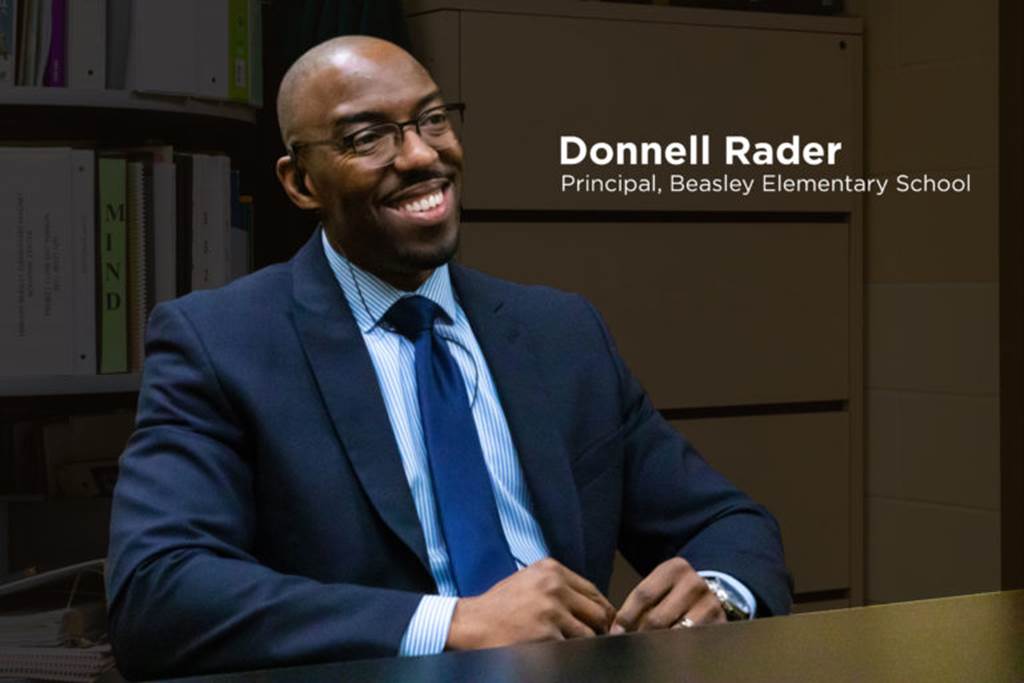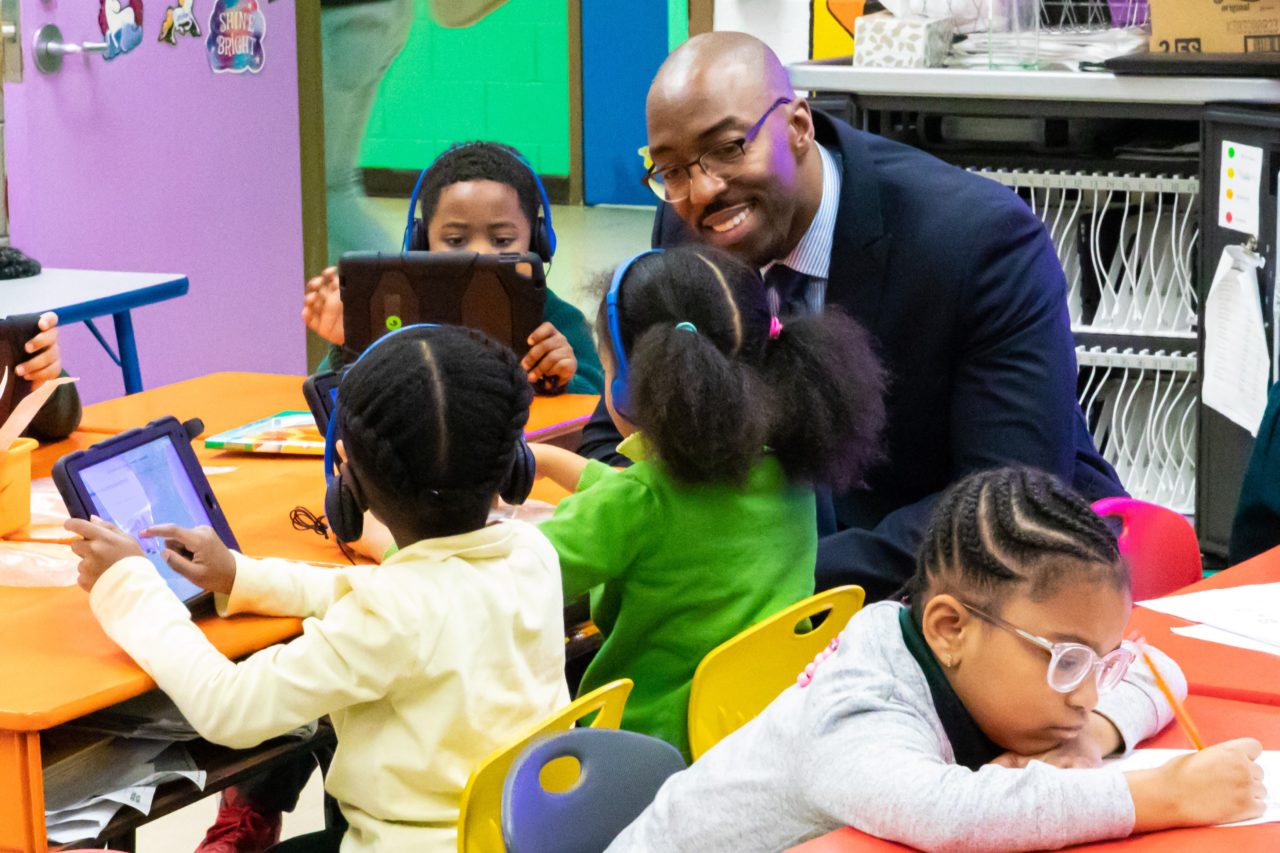Good Books and Great Guidance | Unos buenos libros y una gran guía
15 January 2020
Principal Donnell Rader admits that he wasn’t always the most focused student, but forming a strong bond with his high school English teacher was exactly what he needed to develop a love of reading.

Why Relationships are Key to Strong Reading Growth at Beasley Academic Center
Principal Donnell Rader admits that he wasn’t always the most focused student, but forming a strong bond with his high school English teacher was exactly what he needed to develop a love of reading. A Chicago Public Schools graduate, he found himself drawn to Native Son and Richard Wright’s other works because of his teacher’s persistence in making Wright’s Chicago-centered novels relatable to his life growing up on the South Side. Now, Principal Rader is the principal of Beasley Academic Center, located at the intersection of 53rd and State in the same part of the city where Native Son takes place. And he knows firsthand that developing literacy skills through supportive, student-centered instruction and relevant, engaging texts is the most effective way to prepare students for the next chapter of their lives.
“When you build relationships with students, they feel comfortable taking risks in the classroom,” he said. “Creating a classroom environment where students have the confidence to think critically, dig deep, and attach personal experiences to what they’re reading in the text helps them develop skills that transcend any one subject area.”
Before becoming principal of Beasley two years ago, Principal Rader served as a Multi-Tiered System of Supports (MTSS) coordinator and as an assistant principal, and learned how individualized instruction, targeted supports for students, and professional development opportunities for teachers all improve student outcomes. Since Beasley is a magnet school that also has a gifted program, one of his first priorities was to introduce a standards-aligned, balanced literacy model, one rooted in reading and analyzing novels and other rich informational texts, to increase the rigor of the school’s curriculum in all subjects. As a result of this shift, students are given more opportunities to develop advanced literacy skills by reading and writing about challenging literary texts in both individual and group settings, which in turn helps them dig deeper into their social science, science, and math classes.
To ensure Beasley students could successfully adapt to a more rigorous approach to literacy, Principal Rader first had to train his staff. Teaching gifted students who are up to two full grade levels ahead in reading is no easy task, but Principal Rader says preparing for that challenge was well worth it.
“I worked harder last year than I ever had before in my life to make sure that our teachers are equipped to monitor student progress and identify needs that should be met,” he said. “The greatest resource for students is always going to be trained teachers.”

His push for more rigorous instruction is working—this past school year, Beasley students showed some of the strongest growth in reading in the entire district. Now, the focus is on using student data to guide instruction even further. For Principal Rader, everything connects back to what students are reading in the classroom. He believes that worthwhile texts—citing Charlotte’s Web by E.B. White and Hatchet by Gary Paulsen as two examples—strike an ideal balance of being accessible and challenging. They should also be vividly written to help students explore complex topics. From there, teachers can use different strategies to explain the parts of the text that are hard for students to understand.
“Let’s say we’re looking at Shakespeare—if I’m doing a read aloud with a class, I might stop and say: ‘Hold up, class. Romeo just played Juliet. I can’t believe he treated her life like that.’ I’m speaking their language,” he said. “Then, when I ask: ‘How do you think this is going to affect her throughout the remainder of this story?’ students might say: ‘Well, when you put it like that Mr. Rader, I think she’s going to retaliate.’ This is what makes it accessible for them.”
In addition to making unfamiliar texts feel accessible inside the classroom, Principal Rader also wants to expose his students to new experiences outside of their core subjects that can reinforce their advanced literacy skills. Having started his career as a visual arts teacher, he is always looking for new ways to incorporate the arts into students’ academic routines—from music and dance to everything in between. He also encourages students to diversify their skillsets by taking advantage of Beasley’s unique resources. For example, it is one of the only CPS elementary schools with a pool, and has a partnership with XS Tennis, an organization located right across the street that focuses on making tennis accessible for students from all backgrounds. Regardless of whether a student wants to play a sport or pick up a musical instrument, Principal Rader knows that encouraging students to pursue their interests accelerates academic growth and helps them become well-rounded citizens.
“At the end of the day, every single kid in this building should grow academically,” he said. “I want us to be the highest-performing school on the South Side of Chicago.”
And with a constructive literacy framework at the forefront, Beasley students are already working towards that goal—essay by essay, risk by risk, page by page.

Por qué las relaciones son clave para un desarrollo sólido en la lectura en el Beasley Academic Center
El director Donnell Rader admite que no siempre fue el estudiante más enfocado, pero establecer un fuerte vínculo con su maestro de inglés de la secundaria era exactamente lo que necesitaba para desarrollar el amor por la lectura. Como graduado de las Escuelas Públicas de Chicago, se sintió atraído por Native Son y por otras obras de Richard Wright, debido a la persistencia de su maestro en hacer que las novelas de Wright, ambientada en Chicago, se relacionaran con su vida en el sur de la ciudad. Ahora es el director del Beasley Academic Center, ubicado en la intersección de la calle 53rd y State, en la misma parte de la ciudad donde Native Son tuvo lugar. Y sabe de primera mano que la manera más efectiva de preparar a los estudiantes para el siguiente capítulo de sus vidas es hacer desarrollar sus habilidades de lectura, usando textos relevantes que les brinden apoyo y se centren en ellos.
“Cuando construyes relaciones con los estudiantes, se sienten cómodos tomando riesgos en el aula”, dijo. “Crear un ambiente donde los estudiantes tienen la confianza de pensar crítica y profundamente, y de relacionar sus experiencias personales con el texto les ayuda desarrollar habilidades que pueden aplicarse en cualquier asignatura”.
Antes de convertirse en director de Beasley hace dos años, el director Rader sirvió como coordinador de Multi-Tiered System of Supports (MTSS) y como subdirector. Durante estos cargos aprendió las maneras como la instrucción individualizada, los apoyos dirigidos a los estudiantes y las oportunidades de desarrollo profesional para los maestros mejoran los resultados de los estudiantes. Ya que Beasley es una escuela Magnet que también tiene un programa para estudiantes dotados, una de sus primeras prioridades era introducir un modelo de alfabetización equilibrado y que se ajuste a las normas. Éste se centra en la lectura y en el análisis de novelas y de otros textos informativos rico en contenidos, a fin de aumentar la rigurosidad del currículo de la escuela en todas las asignaturas. Como resultado de este cambio, los estudiantes tienen más oportunidades de desarrollar habilidades avanzadas de alfabetización al leer y redactar sobre textos literarios complejos, tanto individual como grupalmente. Esto a su vez, les ayuda a profundizar sus conocimientos en sus clases de ciencias sociales, ciencias y matemáticas.
Para garantizar que los estudiantes de Beasley pudieran adaptarse exitosamente a un enfoque más riguroso de alfabetización, el director Rader primero tuvo que capacitar a su personal. No era una tarea fácil enseñar a los estudiantes dotados que en lectura se encontraban adelantados en dos niveles de grado. Sin embargo, el director Rader dice que valió la pena haberse preparado para ese desafío.
“El año pasado, trabajé más duro de lo que jamás había hecho en mi vida para asegurarme que nuestros maestros estuvieran preparados para monitorear el progreso de los estudiantes e identificar las necesidades que se debían satisfacer”, dijo. “El mayor recurso para los estudiantes siempre serán los maestros capacitados”.
Su esfuerzo para implementar una instrucción más rigurosa está funcionando: este pasado año escolar, los estudiantes de Beasley mostraron algunos de los crecimientos más sólidos en la lectura en todo el distrito. Ahora, el enfoque está en usar los datos de los estudiantes para guiar aún más la instrucción. Para el director Rader, todo se conecta nuevamente con lo que los estudiantes leen en el aula. Considera que los textos que valen la pena —citando Charlotte’s Web por E.B. White y Hatchet por Gary Paulsen como dos ejemplos —tienen un balance ideal de ser accesibles y complejos. También deben ser escritos vívidamente para ayudar a los estudiantes a explorar temas complejos. A partir de ahí, los profesores pueden utilizar diferentes estrategias para explicar las partes del texto que son difíciles de entender.
“Por ejemplo, si leemos Shakespeare y hacemos una lectura en voz alta con una clase, es posible que me detenga y diga: ‘Esperen, estudiantes’. Romeo jugó con los sentimientos de Julieta. No puedo creer que la haya tratado de esa manera”. Estoy hablando su idioma”, dijo. “Entonces, cuando pregunto: ‘¿Cómo creen que esto la afectará en el resto de la historia?’ Los estudiantes dirían: ‘Bueno, cuando lo dice así, director Rader, creo que ella tomará represalias’. Esto es lo que lo hace accesible para ellos”.
Además de hacer que los textos desconocidos sean accesibles dentro del aula, el director Rader también quiere exponer a sus estudiantes a nuevas experiencias fuera de sus asignaturas principales, ya que pueden fortalecer sus habilidades de alfabetización avanzadas. Habiendo empezado su carrera como maestro de artes visuales, siempre busca nuevas formas de incorporar las artes en las rutinas académicas de los estudiantes, como la música y la danza y mucho más. También alienta a los estudiantes a diversificar sus habilidades aprovechando los recursos exclusivos de Beasley. Por ejemplo, es una de las pocas primarias de CPS con una piscina y tiene una asociación con XS Tennis, una organización ubicada justo al otro lado de la calle que se enfoca en hacer que el tenis sea accesible para los estudiantes de todos los orígenes. Independientemente de si los estudiantes desean practicar un deporte o aprender a tocar un instrumento, el director Rader sabe que motivarlos a seguir sus intereses estimula el crecimiento académico, y les ayuda a convertirse en ciudadanos multifacéticos.
“Después de todo, cada niño en este edificio debería crecer académicamente”, dijo. “Quiero que seamos la escuela de mayor rendimiento en el sur de Chicago”.
Y con un marco de alfabetización constructivo a la vanguardia, los estudiantes de Beasley ya están trabajando para lograr ese objetivo: ensayo por ensayo, riesgo por riesgo, página por página.
Related Stories
25 April 2025
Taking a Leap of Faith: First-Year AP Shares Her Journey to School Leadership
AP Jordan thrives in leading with compassion and love each and every day.
24 April 2025
Creating and Collaborating in Broadcasting Class: Take Five with Roderick Haygood
Before joining CPS, Mr. Haygood gained valuable on-the-ground experience working as a television and radio station supervisor.
23 April 2025
Making a Difference for Students with Disabilities
Ms. D'Vignon sees the importance of ensuring that her students receive a quality education and have a rightful presence in the classroom.
18 April 2025
Celebrating Mariachi in Music Class: Take Five with Phillip Olazaba
Mr. Olazaba is known for being a caring teacher who has high expectations while still making learning fun.




